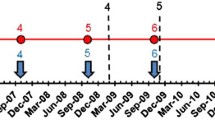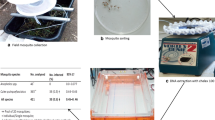Abstract
Lymphatic filariasis (LF) elimination activities started in Mali in 2005 in the most endemic areas and reached countrywide coverage in 2009. In 2004, the district of Bamako was endemic for LF with a prevalence of 1.5%. The current study was designed to determine LF endemicity level in the urban area of Bamako after three rounds of ivermectin and albendazole mass drug administration (MDA). A cross-sectional study was conducted in 2011 in Bamako city, consisting of human prevalence and entomological surveys. Volunteers aged 14 years and above were invited to participate and tested for evidence of Wuchereria bancrofti using night time blood thick smear microfilarial count and blood spots for LF antibodies using the SD BIOLINE Oncho/LF IgG4 Biplex rapid test (Ov16/Wb123). Mosquitoes were collected using CDC light and gravid traps and tested using molecular methods. Poolscreen software v2.0 was used to estimate vector transmission potential. Of the 899 volunteers, one (0.11%) was found to be positive for LF using the Oncho/LF IgG4 Biplex rapid test, and none was found to have Wuchereria bancrofti microfilariae. No mosquitoes were found infected among 6174 Culex spp. (85.2%), 16 Anopheles gambiae s.l. (An. gambiae s.l.) (0.2%), 26 Aedes spp. (0.4%), 858 Ceratopogonidae (11.8%) and 170 other insects not identified (2.3%) tested. Our data indicate that there was no active LF transmission in the low prevalence urban district of Bamako after three MDA rounds. These data helped the National LF programme move forward towards the elimination goal.
Similar content being viewed by others
Data availability
The data that support the findings of this study are available from the corresponding author (Moussa Sangare, mbsangare@icermali.org), upon reasonable request.
Change history
10 November 2022
A Correction to this paper has been published: https://doi.org/10.1007/s00436-022-07718-x
Abbreviations
- CDC:
-
United States Center for Disease Control and Prevention
- DNA:
-
Deoxyribonucleic acid
- GPELF:
-
The Global Programme to Eliminate Lymphatic Filariasis
- ICT:
-
Immunochromatographic test
- LF:
-
Lymphatic filariasis
- MDA:
-
Mass drug administration
- PCR:
-
Polymerase chain reaction
References
Adams AM et al (2018) Eliminating neglected tropical diseases in urban areas: a review of challenges, strategies and research directions for successful mass drug administration. Trop Med Infect Dis 3(4). https://doi.org/10.3390/tropicalmed3040122
Bockarie MJ, Pedersen EM, White GB, Michael E (2009) Role of vector control in the global program to eliminate lymphatic filariasis. Annu Rev Entomol 54:469–487. https://doi.org/10.1146/annurev.ento.54.110807.090626
Cano J et al (2014) The global distribution and transmission limits of lymphatic filariasis: past and present. Parasit Vectors 7:466. https://doi.org/10.1186/s13071-014-0466-x
Castro MC, Kanamori S, Kannady K, Mkude S, Killeen GF, Fillinger U (2010) The importance of drains for the larval development of lymphatic filariasis and malaria vectors in Dar es Salaam, United Republic of Tanzania. PLoS Negl Trop Dis 4(5):e693. https://doi.org/10.1371/journal.pntd.0000693
Chu BK et al (2013) Transmission assessment surveys (TAS) to define endpoints for lymphatic filariasis mass drug administration: a multicenter evaluation. PLoS Negl Trop Dis 7(12):e2584. https://doi.org/10.1371/journal.pntd.0002584
Cook DAN, Pilotte N, Minetti C, Williams SA, Reimer LJ (2017) A superhydrophobic cone to facilitate the xenomonitoring of filarial parasites, malaria, and trypanosomes using mosquito excreta/feces. Gates Open Res 1:7. https://doi.org/10.12688/gatesopenres.12749.2
Coulibaly YI et al (2016) Dynamics of antigenemia and transmission intensity of Wuchereria bancrofti following cessation of mass drug administration in a formerly highly endemic region of Mali. Parasit Vectors 9(1):628. https://doi.org/10.1186/s13071-016-1911-9
Coulibaly YI, Dao S, Traore AK, Diallo A, Sacko M, Traoré SF (2006) Presence and risk of transmission of Wuchereria bancrofti is a reality in rural Mali: the case of the town of Bariambani in the Cirle of Kati. Mali Med 21(1):12–17
Coulibaly YI et al (2015) The impact of six annual rounds of mass drug administration on Wuchereria bancrofti Infections in humans and in mosquitoes in Mali. Am J Trop Med Hyg 93(2):356–360. https://doi.org/10.4269/ajtmh.14-0516
Curtis CF et al (1983) Susceptibility of aposymbiotic Culex quinquefasciatus to Wuchereria bancrofti. J Invertebr Pathol 41(2):214–223. https://doi.org/10.1016/0022-2011(83)90221-5
Curtis CF, Kihamia CM, Ramji BD (1981) Tests of susceptibility of Liberian Culex quinquefasciatus to Tanzanian Wuchereria bancrofti. Trans R Soc Trop Med Hyg 75(5):736–739. https://doi.org/10.1016/0035-9203(81)90166-8
Dahan-Moss Y et al (2020) Member species of the Anopheles gambiae complex can be misidentified as Anopheles leesoni. Malar J 19(1):89. https://doi.org/10.1186/s12936-020-03168-x
de Souza DK, Koudou B, Kelly-Hope LA, Wilson MD, Bockarie MJ, Boakye DA (2012) Diversity and transmission competence in lymphatic filariasis vectors in West Africa, and the implications for accelerated elimination of Anopheles-transmitted filariasis. Parasit Vectors 5:259. https://doi.org/10.1186/1756-3305-5-259
de Souza DK et al (2014) No evidence for lymphatic filariasis transmission in big cities affected by conflict related rural-urban migration in Sierra Leone and Liberia. PLoS Negl Trop Dis 8(2):e2700. https://doi.org/10.1371/journal.pntd.0002700
Dembélé M et al (2012) Implementing preventive chemotherapy through an integrated National Neglected Tropical Disease Control Program in Mali. PLoS Negl Trop Dis 6(3):e1574. https://doi.org/10.1371/journal.pntd.0001574
Erickson SM, Fischer K, Weil GJ, Christensen BM, Fischer PU (2009) Distribution of Brugia malayi larvae and DNA in vector and non-vector mosquitoes: implications for molecular diagnostics. Parasit Vectors 2(1):56. https://doi.org/10.1186/1756-3305-2-56
Farid HA, Morsy ZS, Helmy H, Ramzy RM, El Setouhy M, Weil GJ (2007) A critical appraisal of molecular xenomonitoring as a tool for assessing progress toward elimination of lymphatic filariasis. Am J Trop Med Hyg 77(4):593–600
Fischer P et al (2007) Persistence of Brugia malayi DNA in vector and non-vector mosquitoes: implications for xenomonitoring and transmission monitoring of lymphatic filariasis. Am J Trop Med Hyg 76(3):502–507
Goodman DS, Orelus JN, Roberts JM, Lammie PJ, Streit TG (2003) PCR and mosquito dissection as tools to monitor filarial infection levels following mass treatment. Filaria J 2(1):11. https://doi.org/10.1186/1475-2883-2-11
Joseph H et al (2011) Application of the filariasis CELISA antifilarial IgG(4) antibody assay in surveillance in lymphatic filariasis elimination programmes in the South Pacific. J Trop Med 2011:492023. https://doi.org/10.1155/2011/492023
Katholi CR, Unnasch TR (2006) Important experimental parameters for determining infection rates in arthropod vectors using pool screening approaches. Am J Trop Med Hyg 74(5):779–785
Koudou BG et al (2018) Elimination of lymphatic filariasis in west African urban areas: is implementation of mass drug administration necessary? Lancet Infect Dis 18(6):e214–e220. https://doi.org/10.1016/s1473-3099(18)30069-0
Kuhlow F, Zielke E (1978) Dynamics and intensity of Wuchereria bancrofti transmission in the savannah and forest regions of Liberia. Tropenmed Parasitol 29(3):371–381
Mehta PK, Rauniyar R, Gupta BP (2018) Microfilaria persistent foci during post MDA and the risk assessment of resurgence in India. Trop Med Health 46:25. https://doi.org/10.1186/s41182-018-0107-8
Mukabana WR, Takken W, Knols BG (2002) Analysis of arthropod bloodmeals using molecular genetic markers. Trends Parasitol 18(11):505–509. https://doi.org/10.1016/s1471-4922(02)02364-4
Pichon G (2002) Limitation and facilitation in the vectors and other aspects of the dynamics of filarial transmission: the need for vector control against Anopheles-transmitted filariasis. Ann Trop Med Parasitol 96(Suppl 2):S143–S152. https://doi.org/10.1179/000349802125002509
Rao RU et al (2006) A real-time PCR-based assay for detection of Wuchereria bancrofti DNA in blood and mosquitoes. Am J Trop Med Hyg 74(5):826–832
Sissoko MS et al (2015) Spatial patterns of plasmodium falciparum clinical incidence, asymptomatic parasite carriage and Anopheles density in two villages in Mali. Am J Trop Med Hyg 93(4):790–797. https://doi.org/10.4269/ajtmh.14-0765
Steel C et al (2015) Rapid point-of-contact tool for mapping and integrated surveillance of Wuchereria bancrofti and Onchocerca volvulus infection. Clin Vaccine Immunol 22(8):896–901. https://doi.org/10.1128/cvi.00227-15
Touré YT (1979) Bio-ecologie des Anopheles (Diptera: Culicidae) dansune zone rurale de savane soudanienne au Mali village de Banambani – Arrondissement de Kati: Incidence sur la transmission du Paludisme et de la Filariose de Bancroft. PhD dissertation University of Mali/ISFRA, Bamako, Mali
Acknowledgements
The author would like to express warm gratitude to the many people who gave generously of their time and knowledge in the preparation and the implementation of this study. Especially, the health staff of Bamako district, the community health workers and all the participants.
Funding
This study was supported in part by the Division of Intramural Research, National Institute of Allergy and Infectious Diseases (NIAID), National Institutes of Health (USA), and the University of Science, Techniques and Technologies of Bamako, Bamako, Mali.
Author information
Authors and Affiliations
Contributions
Yaya Ibrahim Coulibaly, Moussa Sangare, Housseini Dolo, Moses John Bockarie, Benjamin G. Koudou, Louise A. Kelly-Hope, Amy D. Klion and Thomas B. Nutman designed and conceived the study.
Amy D. Klion, Louise A. Kelly-Hope, Moses John Bockarie and Thomas B. Nutman approved final version of the manuscript and helped with the analysis.
Yaya Ibrahim Coulibaly, Moussa Sangare, Housseini Dolo, Siaka Yamoussa Coulibaly, Ilo Dicko, Lamine Diarra, Abdoul Fatao Diabaté, Lamine Soumaoro, Michel Emmanuel Coulibaly, Salif Seriba Doumbia and Abdallah Amadou Diallo collected, processed the samples and drafted the manuscript.
Yaya Ibrahim Coulibaly, Moussa Sangare, Housseini Dolo, Benjamin G. Koudou, Amy D. Klion, Louise A. Kelly-Hope, Thomas B. Nutman and Moses John Bockarie managed the data, did the statistical analysis and helped to draft the manuscript. All the authors read and approved the final manuscript.
Corresponding author
Ethics declarations
Ethics approval
A collective quartier-wide oral consent was obtained from village elders and head of quartiers, and all mosquito collectors and participants enrolled in parasitological study signed an individual written consent. The study protocol and consent forms were approved by the Malian National Institute of Research in Public Health Ethical Committee, Bamako, Mali (Reference #9/11/CE-INRSP).
Consent to participate
Informed consent was obtained from all individual participants included in the study.
Competing interests
The authors declare no competing interests.
Additional information
Handling Editor: Una Ryan
Publisher's note
Springer Nature remains neutral with regard to jurisdictional claims in published maps and institutional affiliations.
The original online version of this article was revised due to a retrospective Open Access cancellation.
Rights and permissions
Springer Nature or its licensor (e.g. a society or other partner) holds exclusive rights to this article under a publishing agreement with the author(s) or other rightsholder(s); author self-archiving of the accepted manuscript version of this article is solely governed by the terms of such publishing agreement and applicable law.
About this article
Cite this article
Coulibaly, Y.I., Sangare, M., Dolo, H. et al. No evidence of lymphatic filariasis transmission in Bamako urban setting after three mass drug administration rounds. Parasitol Res 121, 3243–3248 (2022). https://doi.org/10.1007/s00436-022-07648-8
Received:
Accepted:
Published:
Issue Date:
DOI: https://doi.org/10.1007/s00436-022-07648-8




